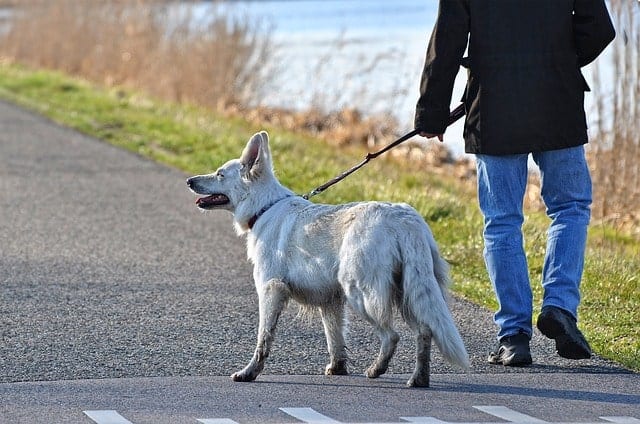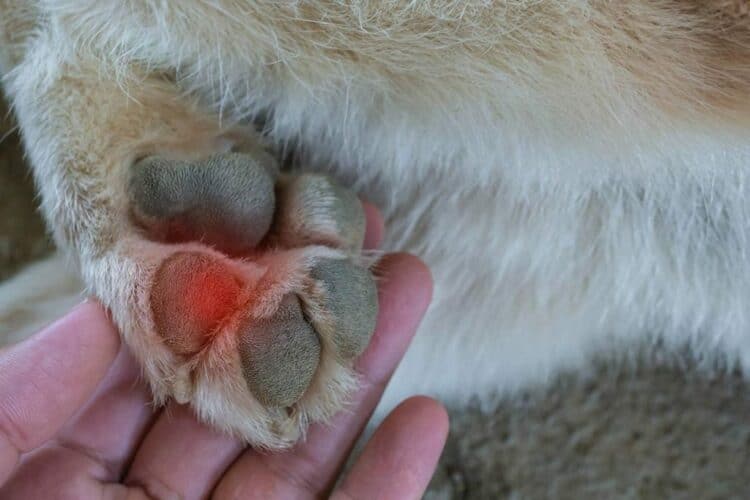Have you ever wondered why dogs get red paws? Does your dog have red paws and you’re concerned about what’s causing it? If this is you, you’ve landed on a spot that will explain four possible reasons why your dog’s paws are red.
Dogs with red paws usually lick and chew the paws, which can exacerbate the problem, making it important to find out the cause and seek treatment if necessary. In this article, we’ll list four possible reasons that cause red paws and what you can do about the issue. Read on to learn more.
The 4 Possible Reasons My Dog’s Paws Are Red
1. Burns From Hot Pavement
Before taking your dog for a walk, it’s crucial to check the pavement or asphalt to see if it’s hot. Simply place your hand flat against the surface. If the surface is too hot on your hand, it will be equally hot for your dog’s paw pads.
A dog’s pads are meant to form a protective barrier against the. When the pads get burned, they may fill with fluid and rupture, causing your dog pain. Apart from obvious red paws, some common symptoms to look for—apart from obvious red paws—are limping, crying out when walking, licking the area, holding the paw abnormally, and blood.
What to Do
First, observe the pad. If the burn looks severe, take your dog to your veterinarian immediately. Burned pads can become infected, and your vet can determine if antibiotics are needed. If it’s not severe, clean the pad with antibacterial soap. You can soak the paw for a bit and then gently remove any debris from the pad. Apply an ointment and wrap it in a bandage. It should take 7–10 days for the pad to heal completely. You’ll want to limit playtime during this healing period.

2. Anxiety
Some dogs have anxiety, and one form of coping with anxiety is to lick and chew at their paws. Licking and chewing at the paws is a type of compulsive disorder that ties into anxiety. Your dog may have separation anxiety when you’re away, or it could be fear-related, such as a dreaded trip to the vet or a loud noise. This can even be a senior dog issue if your dog is developing cognitive dysfunction.
What to Do
If the cause for obsessive licking and chewing of the paws is from anxiety, you’ll want to take your pup to the vet to determine a course of action to prevent the issue. In some instances, medications may be prescribed. Some owners find that CBD oil can help, and it wouldn’t hurt to give it a try. You can also try exercising your dog before leaving your home so that they are too tired to be stressed about being alone.
3. Insect Bite or Sting
A dog may have an allergic reaction to a bite or sting that can cause redness of the paw. Your dog may have stepped on an anthill or maybe even a wasp. If you suspect a sting, look for a stinger—that will tell you for sure if your dog was stung. If you see a stinger, the culprit is more than likely a bee because only bees leave the stinger inside its victim.
What to Do
If you see a stinger, avoid using tweezers because it may cause more venom to enter the site. Instead, use a credit card to flick it away. Apply a paste of baking soda and water to the site. You can also apply ice to reduce swelling.

4. Pododermatitis
Pododermatitis is basically an inflammation of the paws or feet. The condition is usually caused by allergies, infections, hormonal disorders, tumors, cancers, or environmental contaminants. Allergies can be caused by a food allergy, such as corn, wheat, or soy, and infections could come from bacteria, fungus, or parasites.
What to Do
Only your veterinarian can diagnose this condition. If you suspect any of the above reasons regarding pododermatitis, consult your veterinarian. If pododermatitis is the diagnosis, your vet will develop a treatment plan that may involve topical ointments, paw soaks, or corticosteroids. If the symptoms are from a food allergy, the allergen will need to be removed from your dog’s diet. Sometimes, this may take some trial and error.
Conclusion
Prevention is the key for burned pads. Before stepping foot—or paw—on any surface, ensure it’s not too hot. Always inspect the paws if they are red, and use the steps above to determine a course of action for your dog. When in doubt, always consult your veterinarian.
Featured Image Credit: SingjaiStocker, Shutterstock














